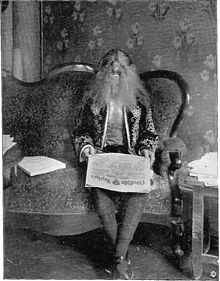Hypertrichosis
| Classification according to ICD-10 | |
|---|---|
| L68 | Hypertrichosis
Incl .: increased hair growth.Excl .: congenital hypertrichosis.Excl .: persistent lanugo hair |
| L68.1 | Hypertrichosis lanuginosa acquisita |
| L68.2 | Localized hypertrichosis |
| L68.8 | Other hypertrichosis |
| L68.9 | Hypertrichosis, unspecified |
| ICD-10 online (WHO version 2019) | |
As hypertrichosis or hypertrichosis ( ancient Greek ὑπέρ : about, θρίξ Hair) refers to the symptom of a more than usual degree of gender-based hair beyond hair density or a hair on the otherwise always hairless bodies.
Classification
The hypertrichosis can occur locally limited in individual places (for example as hairy nevus pilosus , animal fur nevus ) or affect the generalized entire body with the exception of the soles of the feet and palms.
There are congenital forms, generalized see Congenital generalized hypertrichosis .
A congenital form of locally limited hypertrichosis is an increased hairiness over the sacrum that is partly similar to that of the head . This is the case in diseases in which the neural tube was not completely closed during embryonic development (so-called dysraphias ), such as spina bifida .
The lanugo can re-occur after birth as acquired form (hypertrichosis lanuginosa acquisita) ; this is very rarely the case in the context of cancer as a so-called paraneoplastic syndrome, especially in the case of tumors of the intestines ( Herzberg-Potjan-Gebauer syndrome ).
Some drugs can cause generalized hypertrichosis. One example is the blood pressure medication Minoxidil , which, when applied externally, is also used to treat specific hair loss.
Hypertrichosis must be distinguished from all forms of hormonal changes in the gender-specific hair type, which in women are referred to as hirsutism .
In individual syndromes, hypertrichosis can be an essential feature, for example amaurosis-hypertrichosis syndrome , Barber-Say syndrome , Gorlin-Chaudhry-Moss syndrome , Wiedemann-Steiner syndrome .
History of the "hair people" and known cases
In earlier centuries so-called hair people were exposed in many cases to the curiosity of their surroundings; however, they sometimes also used their physical characteristics, more or less voluntarily, as a source of their livelihood. During the Renaissance, hair people lived at the royal courts of France, Italy and the Netherlands, where they were educated and were part of the court as human curiosities. For example, Petrus Gonsalvus and his daughter Tognina Gonsalvus (16th century) are known in the tradition . Some famous hair people worked as freaks at the fairs and side shows of the 19th century, such as Julia Pastrana (1834–1860) and Lionel the Lion Man (1890–1932). Currently, the Thai Supattra Sasupan (born August 5, 2000) is listed in the Guinness Book of Records as the hairiest girl in the world. The myth of the werewolf may also be related to this disease, as is the story of the Beauty and the Beast , allegedly .
literature
- What the forest people tell us . In: The Gazebo . Volume 3, 1874, pp. 59–61 ( full text [ Wikisource ] - with ill.).
Web links
Individual evidence
- ↑ AW Lucky u. a .: A randomized, placebo-controlled trial of 5% and 2% topical minoxidil solutions in the treatment of female pattern hair loss . In: J Am Acad Dermatol. 2004 Apr; 50 (4), pp. 541-553 PMID 15034503
- ↑ Roberto Zapperi : The wild man of Tenerife. The miraculous story of Pedro Gonzalez and his children . CH Beck, Munich 2004.
- ↑ Leslie Fiedler: Freaks. Myths and Images of the Secret Self . New York 1978.
- ↑ Wolfskind Supattra Sasupan: This eleven year old is the hairiest girl in the world . In: Berliner Kurier , July 12th 2011-

